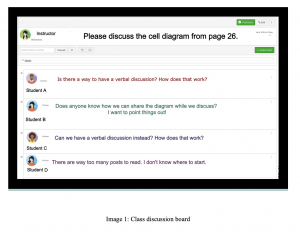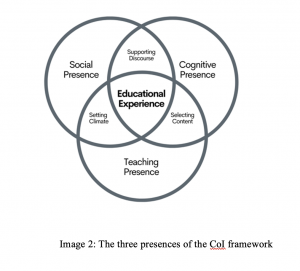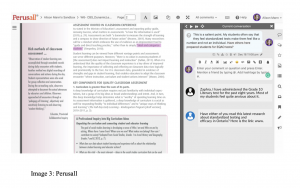7 Chapter 7: Integrating Alternative Forms of Communication in Online Discussions
Alison Mann
Ontario Tech University
Setting the Context
As an educator with over 14 years of online teaching experience (K–12 and higher education), I have come to learn that, when done well, a discussion board can serve as the hub and heart of online learning communities. I have experienced many seasons and styles of online discussion boards, and I continue to explore and develop iterate these based on feedback from students’ experiences. The challenges faced by students in the scenario below illustrate some of the many issues I have observed and (mostly) resolved over time through alternative forms of communication in online discussions. It is my hope that this chapter provides some insights to help you find ways to integrate a variety of communication modes for online discussions in your courses.
Scenario
Have a look at the discussion in Image 1.

As shown, the instructor in an online biology course is experiencing a lack of interaction and engagement on the class discussion board. Some students are asking for additional modes of communication, and it appears that others are having trouble with the threaded discussion format . Student A is an English language learner and is wanting to work on his English skills using both verbal and written communication with his peers. He is hoping there will be opportunities for both forms of communication. . Student B learns best when she can interact visually with course content and loves to highlight text and annotate diagrams. She is hoping there will be an opportunity to discuss course content with peers using visuals. Student C knows that she can excel in discussions when they are verbal, and she also likes to make use of her hands to communicate. With her attention-deficit/hyperactivity disorder (ADHD), she knows that she will struggle with discussions if they can only be typed. She wonders if there are options or alternatives to text-based discussions. Student D is struggling to keep up with the number of posts she needs to read. It is her first online course, and as a busy parent, she would much prefer the ability use audio recordings to respond to her peers’ interesting posts.
Learning Outcomes
- Identify a range of alternative methods and tools to promote online discussions (e.g., video, voice threads, text-based discussion, use of avatars).
- Determine and purposefully select which forms of communication are best suited to discussion topics.
- Understand how different forms of communication can be used to meet the needs of all students (universal design for learning [UDL]/differentiated instruction [DI]).
- Be able to devise and design discussion activities to promote interaction, and active and meaningful learning.
Key Terms: chat-based platforms, collaborative annotation, constructivism, community of inquiry, universal design for learning, online discussions
About This Chapter
While text-based discussions often play an integral role in online learning environments, there are instances where they may not be the best fit for learning objectives or may not be the most effective form of communication for some students.In this chapter, we will discuss and explore how instructors can use alternative forms of communication in online discussions to foster student engagement, interaction, and active learning in fully online, blended, and flipped learning environments. We will also have a look at how using universal design for learning (UDL) can be used to accommodate all students to best suit their communication needs.
We will cover three broad alternative forms for online discussions which include the following items: use of video and audio, chat-based platforms, collaborative annotation and social e-reading tools. While tools and applications change and evolve over time, we will share some examples of promising tools currently in use for online discussions. These forms will be discussed with constructivist learning theory and a community of inquiry framework in mind. Some of the tools that will be explored in this chapter offer alternatives to a text-based discussion in the classroom and are opportunities to embed UDL into courses.
What Does Current Research Tell Us about Discussion Boards in Online Learning Environments?
As a result of recent global and societal circumstances due to COVID-19, online learning has arguably become an integral and necessary dimension in the higher education landscape. Much attention and interest have been focused on better understanding how students communicate and interact in online contexts. Arguably, discussion boards are one of the most common strategies used to support student interaction and communication in online learning environments. Facilitating community in online learning environments is crucial and the discussion board can often act as a central hub for community building and interaction. Both constructivist learning theory and the community of inquiry framework have fundamentally shaped online discussion boards.
Constructivist Learning Theory and Online Learning
A constructivist approach to teaching fosters active learning, builds community, and places emphasis on student-centred learning. There is little dispute that constructivism is a key driving theory behind principles of online learning (Dooly, 2008). Discussion boards, alongside video conferencing, chat rooms, synchronized whiteboards, and interactive presentation tools, are helpful participatory tools used to maintain effective social interaction and student engagement in constructivist online learning environments. Incorporating alternative forms of communication, such as video and audio, can further enrich and deepen interactions and offer students a choice of communication mode(s).
The Community of Inquiry Framework
The community of inquiry (CoI) is a highly used framework for online course design. The CoI framework is a model that considers three presences – social presence, cognitive presence, and teaching presence – as central to the educational experience. Social presence is the capacity to present oneself socially through personal characteristics and effects in an online context (Community of Inquiry, n.d.). Cognitive presence refers to the relationship between a student’s personal understanding and discourse with peers (Community of Inquiry, n.d.). Teaching presence can be described as the course design, facilitation, and development of community in online learning contexts. Teaching presence directs both cognitive and social processes to provide meaningful student learning experiences (CoI, n.d.). Social and teaching presence can be elevated using multi-modal tools, including video and audio recordings or virtual meetings . Using a variety of forms of communication such as video, audio, avatars, and text in discussion boards can significantly increase relational interaction and foster engagement. For a primer on the community of inquiry framework, please click HERE. For more on constructivist approaches using CoI, see Swan (2017).

Placing Universal Design for Learning at the Centre of Course Design
Universal Design for Learning (UDL) is one of the most effective course design frameworks instructors can use to provide all students, regardless of their background and ability, equal opportunities to learn and succeed. Offering all students multiple means of engagement through flexibility and choice, and by addressing the diversity of student needs, ultimately leads to a more inclusive and effective learning experience. For more on the UDL framework, see the Center for Applied Special Technology (CAST).
The following section will provide an overview of three alternative forms of discussion-based learning in online environments: video and audio, collaborative annotation and discussion platforms, and chat-based platforms.
Disclaimer: Before integrating or using any of these tools and apps for your courses, check with tech support at your institution to ensure compliance and privacy issues are met and are suitable for the diverse needs of students (e.g., Accessibility for Ontarians with Disabilities Act [AODA] and Freedom of Information and Protection of Privacy Act [FIPPA].
Video and Audio
Video and audio tools can enrich discussion, increase human connection online, and add a personal dimension to responses. The use of video in online discussions has been known to enhance group cohesion and affiliation, thereby boosting student participation and engagement (Pinsk et al., 2014). In one study, video-enabled discussions were found to be more effective than text-based discussion at creating social and teaching presence (Clark et al., 2015).
Furthermore, video and audio features are now embedded in most learning management systems (e.g., Canvas, Blackboard, Moodle, and more). These embedded features are accessible and easy to use, and students can record multiple takes until they are pleased with their response.
Using External Applications for Video and Audio Discussion
Learning management systems are not necessarily required for video and audio discussions to take place in online learning environments. One current app that has gained much success in both K–12 and higher education online contexts is Flipgrid. Using Flipgrid, instructors can assemble “grids” to facilitate video discussion, which is similar to the look of a message board. An instructor can provide a question and students can reply for all to view. At this time, there is no limit to the number of responses on the grid, however, one constraint is that students can only reply to the instructor’s post and not directly to those of their peers. Flipgrid can be used as a stand-alone tool or can be integrated into existing learning management systems. With the latter option, students do not need to sign in to Flipgrid and there are fewer clicks required.
Considerations: Video and audio tools add a personal dimension to responses. In video, students can view facial expressions, tone, and hand gestures, which can greatly enhance meaning and even avoid misunderstanding or ambiguous text. This feature has been shown to be particularly helpful for English language learners. Having a choice of text, audio, and video response for discussion can increase confidence and agency.
The use of video and audio features requires a webcam and audio-recording capabilities, which may not be available to all online learners. An initial course survey can be used to gather information on access to technology and broadband prior to the start of lessons. Additionally, discussion board features may not offer subtitle captioning, which can pose a barrier for some students.
Collaborative Annotation and Discussion Platforms
Another emerging and dynamic alternative approach to discussion boards is collaborative annotation and discussion platforms. Also known as “social e-readers,” these tools allow multiple learners to critically engage with a text or object synchronously or asynchronously. Learners can engage cognitively with course materials and their peers by marking up texts/objects, responding to prompts, engaging in discussions, asking questions, and more. Just like how a student can highlight a textbook and add notes in the margin, social e-readers go a step further and allow all users to highlight and take notes collaboratively and interact with comments by others. Collaborative annotation tools can capture student thinking and processing in themoment (Adams & Wilson, 2020) and can help instructors identify gaps and challenges with student understanding.

Perusall is an example of a free social e-reader and has gained much traction in higher education in online, flipped, flex-mode, and in-person classes (see Image 3). Designed at Harvard University, Perusall is supported by ongoing research and can be integrated into learning management systems or used directly on their websites. Perusall designers aim to target intrinsic social motivation and extrinsic motivation . They explain that intrinsic motivation is achieved by leveraging a student’s natural drive to have collective experiences and interactions with peers. Interactions on Perusall occur through class chat, peer-to-peer chat, annotations on course content, and by peers asking questions and providing answers. Recognizable social media discussion features such as emojis, hashtags, and upvoting make interactions more appealing for users. Extrinsic motivation is achieved through the ability for students to monitor their own progress and level of interaction. Perusall can be automated to gently “nudge” students to engage with course content when needed. Finally, instructors can track each student’s progress through course analytics to monitor active reading, number of comments and annotations, as well as upvoted comments. A social e-reader like Perusall uses a constructivist approach to learning because it places students at the centre of the learning experience and encourages them to build meaning together. The instructor’s role in this environment can be to facilitate and scaffold student learning through probing, asking questions, and redirecting discussions when required.
Considerations: Students can be placed in groups according to need. Assignments can be modified for each learner (e.g, an alternative reading for ELL students). A “confusion report” can be generated to indicate areas in the course content where questions are most frequently asked and where students may be struggling with content.
Chat-Based Platforms
Chat-based platforms are another effective alternative to traditional discussion boards. Chat-based platforms such as Discord and Slack offer participants a robust space to communicate using many of the recognizable elements and features of social media platforms such as liking, using reactions, tagging, and direct messaging. Research has noted how students tend to communicate during their courses through other means, such as Facebook, Instagram, and WhatsApp (de Lima et al., 2019) and often use these spaces for backchannelling. Social media backchannelling refers to social chats, often initiated and organized by students, as an informal space to discuss course work. Because students are already accustomed to social media chat, embedding chat-based platforms is an efficient way to initiate online discussion using recognizable features and a quick learning curve. Students have expressed that chat-based platforms feel more spontaneous and add a sense of vitality to the learning experience (de Lima et al., 2019). In the same way discussion board forums can be organized by topic or theme, chat-based platforms, such as Slack, use “channels” to keep discussion topics focused and organized.
Considerations: Ensure the chat-based platform you use fits with your institutional requirements.
Reflecting Back on the Scenario
This chapter has shared some practical alternative forms of communication for online discussions. As we have learned, oOffering alternative forms of communication has the potential to meet the needs of all learners and can increase student, teacher, and cognitive presence significantly. If we circle back to our scenario from the beginning of the chapter, what alternative approaches might you now consider for the online discussions in the class? What could have been done differently? Which tools do you feel ready to explore?
Remember, while While new apps, tools, and programs continue to evolve and emerge in online environments, it is up to instructors to ensure that the foundations of effective online teaching are prioritized, such as implementing the community of inquiry framework, taking up a constructivist learning approach, and applying the UDL framework. Together, these approaches can help build a meaningful and engaging online community.
References
Adams, B., & Wilson, N. (2020). Building community in asynchronous online higher education courses through collaborative annotation. Journal of Educational Technology Systems, 49(2) 250–261. doi:10.1177/0047239520946422
Brett, C. (2009). Educational perspectives on digital communications technologies. E-Learning and Digital Media, 6(3), 281–291. doi:10.2304/elea.2009.6.3.281
Clark, C., Strudler, N., & Grove, K. (2015). Comparing asynchronous and synchronous video vs. text-based discussions in an online teacher education course. Online Learning, 19(3), 48–69. https://files.eric.ed.gov/fulltext/EJ1067484.pdf
Community of Inquiry. (n.d.). Description: Social presence. Retrieved December 17, 2021, from https://coi.athabascau.ca/coi-model/description-social-presence/
de Lima, D. P. R., Gerosa, M. A., Conte, T. U., & Neto, J. F. M. (2019). What to expect, and how to improve online discussion forums: The instructors’ perspective. Journal of Internet Services and Applications, 10, Article 22. https://doi.org/10.1186/s13174-019-0120-0
Dooly, M. (2008). Telecollaborative language learning. Lang.
Pinsk, R., Curran, M., Poirier, R., & Coulson, G. (2014). Student perceptions of the use of student- generated video in online discussions as a mechanism to establish social presence for non- traditional students: A case study. Issues in Information Systems, 15(1), 267-276.
Swan, J. (2017). The challenges of online learning: Supporting and engaging the isolated learner. Journal of Learning Design, 10(1), 20–30. https://doi.org/10.5204/jld.v9i3.293

